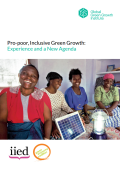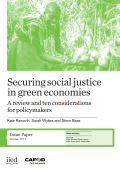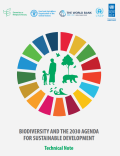
Green growth initiatives to date have often placed the economy and environment front and centre. However, for green growth to fulfil its promise, it needs to also focus on people and address systemic causes of poverty and social exclusion.
Green growth that does not deliver benefits to all stakeholders will not lead to the kind of transformative change envisioned by the global community and outlined in the Sustainable Development Goals.
The ‘Pro poor, inclusive green growth’ report demonstrates how green growth can address some of the drivers of poverty and social exclusion.
Published by the Global Green Growth Institute (GGGI) in association with the International Institute for Environment and Development (IIED) and the Green Economy Coalition (GEC), the report stresses that to be effective green growth strategies will need to strengthen institutional and governance structures and respond to people’s needs.
Drawing from a number of case studies the publication provides practical steps for policymakers, business and civil society to work together to deliver inclusive green growth.

‘Green economy’ and ‘green growth’ policymaking is moving to the centre of many national development strategies. Green policies should enable countries to manage their natural resources more sustainably and efficiently, diversify into new green markets and secure the environmental foundations of development. But do they automatically increase social justice?
Green and just development requires two key ingredients: integrated policymaking and a holistic outcome framework combining environmental, social and economic objectives. Focusing on developing countries, this paper draws on learning from national case studies and international analyses. It concludes with ten critical considerations for shaping green and just national strategies and policies.

'Inclusive green growth' is no longer just a buzz term. It is shaping donor priorities, influencing national development plans and attracting investment. Yet inclusive green growth policies commonly promoted by international institutions make little, if any, reference to informal economies - which are expanding in all parts of the world in response to changes in our formal economies - and which cater for the world's poor. What does Green Economy mean in the context of informal markets where the world's poorest and most vulnerable people produce and trade? Does 'greening' necessitate formalisation, or can it happen through people's own actions?

Many countries are exploring their prospects for green growth. It has become a hot topic, proving attractive to governments, companies, and civil society groups alike. The 2012 Rio+20 Summit concluded that green growth is best defined and tailored according to the individual country context. This report describes Zambia’s approach to develop a Zambian Inclusive Green Growth Strategy under its Sixth National Development Plan.
The Zambian definition for inclusive green growth, is ‘inclusive development that makes sustainable and equitable use of Zambia’s natural resources within ecological limits’. The report describes the changing international policy and financial context for inclusive green growth, reports on a workshop facilitated by IIED, and proposes initial steps to develop its operational Strategy.

The Strategic Plan for Biodiversity 2011-2020 and its Aichi Biodiversity Targets adopted by the Convention on Biological Diversity has been recognised as setting the global framework for priority actions on biodiversity. The 2030 Agenda is consistent with other existing international commitments, including the Strategic Plan for Biodiversity. The SDGs and the Strategic Plan are mutually supportive and reinforcing, and therefore the implementation of one contributes to the achievement of the other.
